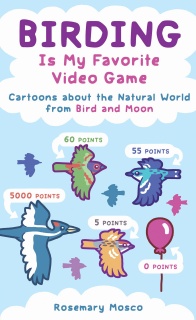“Birding is my Favorite Video Game” from Rosemary Mosco is a light-hearted non-fiction comic; packed with information and fun facts, it’s also funny and insightful, and a wonderful introduction to the world of animals.

Written and illustrated by Rosemary Mosco
Birding is My Favorite Video Game is a collection of fun, quasi-educational comics combining weird science, cute visuals, sweet wit, and a strong environmental message. Based on the popular webcomic Bird and Moon, this collection brings facts about birds, bees, and insects to life in the quirkiest, most wonderful way.
I spend my mornings spying on baby peregrines. I whisper my secrets to a python named Odo. Age aside, I’m probably the target audience for this book. But this collection, based on Rosemary Mosco’s webcomic “Bird and Moon”, is silly enough – and wise enough – to have a broader appeal than just this reviewer.
First off: they’re not all bird comics, and they vary in silliness, from gags about microbes to facts about ocean acidification. It’s a grab bag, and the format itself varies: you’ll get everything from panels and gutters to algorithms spanning double page spreads. (That last one indicates what to do if you find a baby bird.)
Accordingly, the comics vary in density. On one end of the spectrum is a spread featuring mnemonics for remembering the different calls of birds. Featuring twenty-four small illustrations of birds – each of which incorporates a li’l joke about the sound it makes – it’s a ton of detail all at once, particularly when you pay attention to the different physiological characteristics of each bird.
On the other end of the spectrum, there’s a four-panel bit about a gnarly amphibious mating ritual. The species in question isn’t specified (it’s safe to say I’m curious), and it feels more like an straight-up comic strip.
Throughout, Mosco’s art style is smooth and clear. It has a distinct “webcomic” look, which I find hard to quantify except to say that it feels optimized for viewing in a browser window, with thick lines and bright blocks of colour. Overall, it’s easy going, with intuitive lettering and confident compositions guiding your eye across each page.
The level of naturalistic detail varies – from what might as well be scientific illustrations of plants, all the way up to cuddly cartooned turkeys. Regardless, the species are kept recognizable, with their tell-tale markings and specialized adaptations intact. In particular, a page about the real-life creatures that most resemble dragons of legend lets the animals do all the work, with crests and frills and unique markings all clamouring for your attention. (Props to Regalecus glesne for being fabulous.)
Some pages are more like science-class posters: there’s one showing the size difference between different species, and another, in a pixel-art style, listing endangered species. The design is on point each time, keeping the flow of information clear.
A few comics, particularly those in black and white, seem like earlier works, and don’t read as smoothly; the compositions as well as the humour in these can be puzzling. In others, the information is confounded in favour of the gag; a page about the difference between “venomous” and “poisonous”, while entertaining, will leave you more confused than when you came in.
And a few pages feature less humour but succeed nonetheless: the comic about ocean acidification is compact and fluid, and practical in its advice, and wouldn’t have been hurt at all if it had been expanded to multiple pages. In fact, that’s likely my main criticism of this collection: that it really feels like a collection, when the page count could allow for longer pieces and more in-depth forays into each topic. Maybe Rosemary Mosco’s entry to First Second’s “Science Comics” series would scratch that itch, but I guess we’ll leave that to another review.
The very best comics balance information and humour in a way that feels natural. The page featuring animal dating profiles is a great example – it’s a fun and somewhat cheap joke which happens to deliver four different nuggets of information in a way that genuinely made me laugh.
The last section of the book is a visual index, featuring animals discussed in the book alongside their scientific names. It’s a neat reference, and it underscores the sheer number of species Mosco fits in the book.
All told, “Birding is my Favorite Video Game” isn’t a non-fiction comic of the strictly educational variety, but it sparks interest by drawing attention to the weird, wonderful, and funny in the world of nature. While it doesn’t succeed all the way through, it’s got charm in spades as well as useful information. I’d recommend it to fans of birds, slime, and xkcd – and to snake ladies of all ages and genders.






